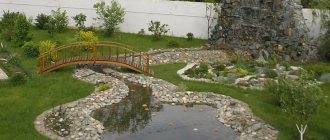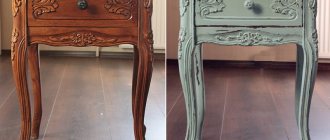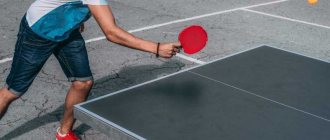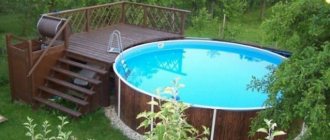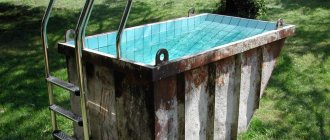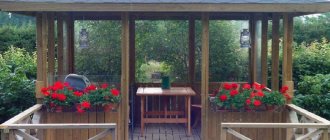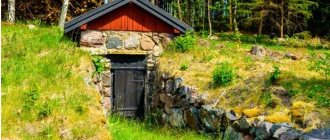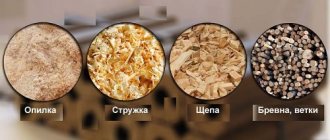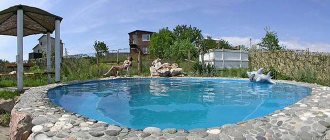Decorating a site is a favorite pastime of summer residents and homeowners. Beautiful flower beds, flower beds and even beds are a true decoration. However, nothing pleases the eye more than ponds and ponds surrounded by beautiful vegetation. And if a stream of water still comes out of it, then the corner turns into the best resting place. If you still manage to make not only a fountain with your own hands, but also beautiful lighting, put a swing or bench nearby, in the evenings all the inhabitants will gather on this patch.
This fountain is DIY and so is the lighting: a waterproof LED light with remote control for changing colors
Fountain pumps
You can do without a pump if there is a centralized pressure water supply on the site. Water is conducted into the tank and released from a vertically installed pipe with a sprayer attached to it. Its excess is sent through the drain pipeline to the sewer or to water the garden. Or they are pumped into a storage tank using a pump.
But constant operation of such a fountain is impossible: you can admire it only for a short period of time while watering occurs or the container is filled. Therefore, a more common and simpler way to make a fountain with your own hands at the dacha is to install a special pump in a water tank, which sucks in water through a filter and then throws it out through the outlet pipe with a spray nozzle installed on it.
Fountain design diagram Source stroychik.ru
Types of fountain pumps
When choosing a pump, you first decide on the type of installation: in the tank itself or outside it, “on land”. Accordingly, it must be submersible or surface.
- Submersible pumps.
They are usually characterized by low power, low energy consumption, quiet operation and affordable price. And ease of installation and operation, since you can make a fountain in the yard without the use of hoses and pipes.
Such pumps are equipped with a platform or suction cups for installation on the bottom Source fontan-shop.ru
- Surface pumps.
Such units are more powerful and noisier. They are installed next to a reservoir, and to suck water from it, a hose or pipeline with a filter at the end is pulled. The second hose with a nozzle is returned from the pump to the reservoir or laid on the top of the cascade when constructing a fountain with a waterfall.
Waterfall design diagram Source i.ibb.co
Surface pumps need protection from the sun and precipitation, so they are placed in a nearby room, a specially made caisson, or covered with a casing. They are more difficult to install and more expensive, but these disadvantages are compensated by high power, reliability, durability and ease of maintenance.
Advice! Having thought about how to build a fountain, you need to immediately decide on its size, the depth of the tank, the desired height of the water column in order to select a pump with the required power, pressure and other parameters.
See also: Companies that specialize in landscape design and gardening.
Types of nozzles
Most fountain pumps are equipped with flow regulators and a set of interchangeable nozzles, with which you can change the type of stream and its intensity to your taste.
Main types of fountain sprayers Source i.ibb.co
They can be single or multi-tiered, releasing thin jets and forming a continuous water wall in the form of a hemisphere or fish tail. Geyser nozzles create bubbles similar to soap bubbles, and distribution manifolds in the form of an arc with pipes release several jets at once, located in a circle.
When equipping a fountain in the yard with your own hands, how to make it as effective and diverse as possible is decided with the help of such nozzles. They can be purchased separately, choosing products with a connection diameter corresponding to the pressure pipeline.
Components of success
Obviously, making a fountain flow is too wasteful: drinking water is not cheap, and its disposal in the simplest and most obvious way will mean an abundance of dirt and puddles on the site. Our choice is a closed system, in which recirculation is provided by a pump.
What will be needed to organize it?
- Capacity. It should be large enough so as not to require frequent replenishment of the water supply: the main problem of mini-fountains is precisely that due to evaporation and splashing, the miniature pond rapidly becomes shallow.
- An area around the container that ensures there are no puddles in windy weather.
Without it, the surroundings of the fountain will quickly turn into a swamp.
Please note: the site should have a slight slope towards the center. In this case, the water from the wind-blown stream will be properly returned for recirculation.
- Power supply. Powerful pumps are powered by 220 volts, so to connect them you only need to ensure that the cable connections are sealed and protected from mechanical damage. Low capacity applications may require a converter with 12 volt DC output.
- The actual pump. Technically, nothing prevents you from using any drainage; however, specialized devices look much more preferable - fortunately, their price starts from a little over a thousand rubles.
- Decorative design. In most cases, the fountain is decorated with natural stone - boulders placed on the bottom and around the container; however, the reader’s imagination may well suggest unconventional solutions.
Tanks, reservoirs and reservoirs
The size of the structure can be very different. It is from the desired dimensions that you need to start when choosing a bowl. If you are thinking about how to make a small fountain in the country with your own hands, a large flowerpot mounted on a pedestal, or even an ordinary basin dug into the ground and decorated around the circumference with pebbles, is suitable for this. All that remains is to fill it with water, lower the pump and connect it to the network.
For a more solid structure, you can also choose a tank by purchasing a ready-made one in a store or by adapting an old bathtub. Finished containers are made of plastic and composite materials. The former are cheaper, but are not highly durable, the latter are more expensive, have considerable weight, but last a long time.
The container for the reservoir can be chosen in any shape and size Source prom.st
Gift - to the studio
Aren't you scared by the front of work? For those who find a significant amount of work burdensome, the current market can offer a ready-made solution, and at a very low cost. Garden and country fountains made of polystone just need to be installed on a flat area, pour water into the container and turn on the power.
Just add water.
Perhaps an unfamiliar term needs clarification. What is polystone?
The origin of the term is obvious: poly - from “polymer”, stone - a transcription of the English “stone” (stone).
The exact composition of the material is not widely available and is probably a trade secret of the manufacturer, the Chinese company Acrilica; however, since it is marketed as an acrylic stone, it is not difficult to guess the main components.
- Aluminum trihydrate Al(OH)3 (more precisely, white clay consisting of a little less than entirely of it).
- Acrylic resin (in solid form, better known to us as plexiglass).
- Mineral pigments that give artificial stone a natural appearance.
Since our material is a typical thermoplastic that can be cast (as well as glued, cut and sanded), it can be used to produce products of any complex shape. How is it different from natural stone?
| Property | A natural stone | Polystone |
| Pores | Eat | No |
| Pollution | Inevitable | Practically do not accumulate; dust and lime deposits can be easily removed with any detergent |
| Frost resistance | Limited (water freezing in the pores leads to cracks) | Not limited |
| Chip resistance | Absent | The viscosity of acrylates allows them to withstand impact loads |
The cost of products starts from approximately 1,500 rubles.
Please note: many manufacturers supply garden and country fountains of the lowest price category without a pump.
Video description
The installation of a tank for a decorative pond and fountain is shown in the video:
Making a bowl with your own hands
If you can’t find a suitable container in the store, you can take a different approach to the question of how to build a fountain in your dacha with your own hands. To do this, you will need sand, geotextiles and pool film or regular thick polyethylene film (it is cheaper):
- First, a pit of the required size and depth is dug.
- After removing roots, stones and other protrusions, the bottom is carefully compacted and covered with sand.
- Then the pit is completely covered with geotextiles to prevent plant germination.
- The film is laid loosely on top of the geotextile. It should not be pulled, and the edges should extend to the surface of the ground at least 25 cm.
- Along the perimeter, the edges of the film are pressed with boulders; pebbles and rounded stones without sharp edges that can damage the waterproofing are also placed on the bottom of the bowl.
Ready reservoir for a fountain Source i0.wp.com
How to choose a place on the site
If you decide to build a fountain from scratch without a ready-made reservoir on the site, it is important to consider several rules for choosing a suitable location:
- It is necessary to provide partial shade, which protects the water from blooming due to strong heating by the sun's rays.
- Avoid areas near large trees. Their powerful roots can cause damage to waterproofing, and falling leaves and branches will clog the water.
- Do not install a jet fountain near the house so that the splashes do not damage the walls.
- They provide a good view of the fountain from different points in the dacha area.
Waterfall device
It is a little more difficult to solve the problem of how to build a fountain in a country house with a waterfall. Additional work will have to be done, namely:
- build a cascade of stones on the edge of the reservoir;
- lay a pipe from the pump outlet to its top.
The cascade can also be bought ready-made or made from large stones, secured with cement mortar.
Ready-made design for a waterfall Source i.ibb.co
During the process of laying the cascade, a pressure hose from the reservoir must be laid between the stones if a submersible pump is used. Or the suction pipeline of a surface unit, for which it is necessary to immediately prepare a place protected from precipitation.
"Ring"
The structure has separate small holes placed in a circle.
Our article contains photos of a garden fountain. They show all the views and clearly show how the water is supplied.
Briefly about the main thing
Before you build a fountain with your own hands, you need to think about its parameters: the size and depth of the bowl, the height to which the water column should rise, the method of decoration. Then you can buy or build a water tank yourself and select a pump. To install a finished bowl, just dig a pit under it and add a layer of sand. A homemade pond is waterproofed with geotextiles and film. To install a fountain, you can purchase a submersible pump and install it at the bottom. Surface mechanisms are placed on the shore and a suction and pressure pipeline is connected to them.
Ratings 0
For the pond
If there is a pond on the site, you can install a light and music floating fountain, for example, the Pondtech R1500 brand.
This design is distinguished by an aesthetic design, as well as a color effect that, when intersected with water cascades, creates an amazing picture. You can independently adjust the color palette, music and water pressure.
Water supply schemes
It is theoretically possible to supply water to the fountain according to three schemes:
- from a water pipe;
- using a “water pump”;
- electric pump.
To create a DIY fountain without a pump, try using the pressure in a water pipe. However, modern people, obviously, will not even consider this option, since pouring water into the sewer for the sake of aesthetic pleasure is an unacceptable idea, taking into account the huge bill for cold water supply.
The second option involves using a tank located above the nozzle level. The pressure here will be low, and the water in the tank will not last long.
In addition, precious moisture, as in the first case, will flow into the pipe, which no summer resident will allow. If, for example, water is used in a circle, pumping it from a bowl into a barrel, then why use a barrel if the electric motor can be used directly?
Thus, the option with an electric motor pumping water from the bowl into the nozzle, or supplying it from the bottom up to the source of the cascade, can be considered realistic. This is an ideal option that allows you to endlessly rotate one small volume of water, adjust the pressure or flow. Of course, most summer residents prefer this particular scheme.
